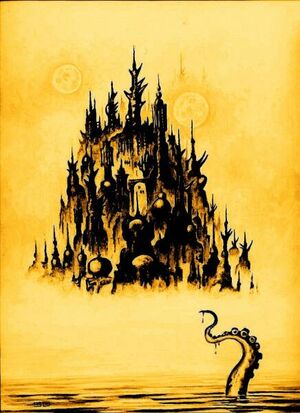
An illustration of Carcosa, artist unknown
Carcosa is a fictional city at the heart of the Carcosa Mythos.
Origins in fiction[]
It was first mentioned in the Ambrose Bierce short story An Inhabitant of Carcosa (first published 1886). In Bierce's story, the ancient and mysterious city is barely described and is viewed only in hindsight (after its destruction) by a character who once lived there.
The city was later used more extensively in Robert W. Chambers' book The King In Yellow, though still without greatly clarifying its exact nature. Chambers had read Bierce's work and also borrowed a few other names (including Hali and Hastur) from Bierce's stories.
In Chambers' book, and within the apocryphal play (also titled The King In Yellow) mentioned several times within its stories, the city is a mysterious, ancient, and possibly cursed place. The most precise description of its location given is that it said to be located on the shores of Lake Hali in the Hyades star cluster. The descriptions given of it, however, make it clear that it is probably located on another planet, or possibly even in another universe, although real world locations have also been suggested. Lin Carter has used it as the name of a planet, the site of the Immemorial City.
Its name may have originally been derived from the medieval city of Carcassonne in France.
Description of Carcosa[]
In The Repairer of Reputations, the following statements about Carcosa are made:
- there are black stars overhead;
- the "shadows of men's thoughts lengthen in the afternoon";
- it is lit by twin suns that sink "into the lake of Hali".
In the Court of the Dragon mentions the black stars hanging in a bright sky, with the wet winds off the Lake of Hali chilling the narrator's face. In The Yellow Sign the cloud waves of The Lake of Hali are also mentioned.
In Litany To Hastur, Lin Carter describes Carcosa as having black domes and monolithic towers.
The Rest Of Your Life sets Carcosa in America as a sort of afterlife or spiritual trap.
Many descriptions associate it with soaring towers and it may be associated with the image of the Dark Tower (which is described as the entrance to the Turning City, which may be Carcosa, in To The Tower, Childe Rowland.
For further discussion of its location see Location of Carcosa.
The Song of Lost Carcosa[]
- Along the shore the cloud waves break,
- The twin suns sink behind the lake,
- The shadows lengthen
- In Carcosa.
- Strange is the night where black stars rise,
- And strange moons circle through the skies,
- But stranger still is
- Lost Carcosa.
- Songs that the Hyades shall sing,
- Where flap the tatters of the King,
- Must die unheard in
- Dim Carcosa.
- Song of my soul, my voice is dead,
- Die thou, unsung, as tears unshed
- Shall dry and die in
- Lost Carcosa.
- —"Cassilda's Song" in The King in Yellow Act 1, Scene 2
Other appearances[]
Later writers, including H. P. Lovecraft and his many admirers, became great fans of Chambers' work and incorporated the name of Carcosa into their own stories, set in the Cthulhu Mythos. In the stories of August Derleth and a few others Carcosa is the residence of the Great Old One Hastur. Occasionally, Hastur will alter reality and merge parts of Earth into Carcosa, usually bringing along unwilling people as well.
In the short story More Light, in which James Blish presented his version of a complete text of the play The King In Yellow, Carcosa was described as having four singularities: that it appeared overnight, that no one could tell whether it sat upon the waters of Lake Hali or beyond them on the unseen farther shore, that the rising moon appeared to be in front of the city's towers rather than behind them, and that one knew the city's name to be Carcosa the moment one looked upon it. In Blish's version, Carcosa was created as a city of exile for the King in Yellow, because he was not king in Aldebaran.
Marion Zimmer Bradley also used the name Carcosa for a city on her fictional planet Darkover. According to her, this usage and the appearance of other distinctive names from Chambers' work dated from her own youthful fascination with The King In Yellow and her ambitions to produce her own reconstruction of the play on the basis of the fragments in Chambers' works. Only later did she transform those early fantasy writings into science-fiction by relocating them from a parallel earth to a distant world under a red sun.
Carcosa is also the name of a game setting for Dungeons and Dragons/Lamentations of the Flame Princess.
Carcosa Press[]
Carcosa Press was a speciality publishing firm formed by David Drake, Karl Edward Wagner, and Jim Groce who were concerned that Arkham House would cease publication after the death of its founder, August Derleth. Carcosa put out two notable collections of pulp horror stories, Manly Wade Wellman's Worse Things Waiting (1975) and Hugh B. Cave's Murgunstrumm and Others (1978), both edited by Wagner and illustrated by Lee Brown Coye.
The Carcosa Press colophon depicts the silhouette of a towered city in front of three moons.
Not to be confused with the fictional publisher of the same name.
